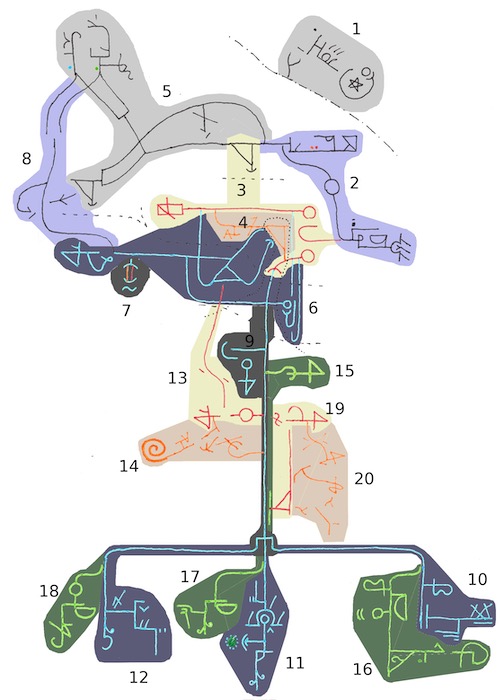- tags
- Language
- resources
- https://s.ai/nlws/
A fascinating writing system based on glyphs connected to each other to create meaning. The system is quite advanced and reading its grammar is like discovering some new alien language. It was created by Alex Fink and Sai in 2010.
This is the kind of complexity that would be incredible to discover in open-ended evolving language systems. A system starting from elementary components and no particular assumption about what language should be, could come up with such exotic models (probably even more exotic in the case of a truly open-ended system).
Examples
Interpretation of the Prayer of St. Francis

Figure 1: This is an interpretation of the prayer of St. Francis written by Alex Fink and Sai. A detailed explanation is available at Sai’s website.
The stones story

Figure 2: An example of Unker non-linear writing system (UNLWS) with translation from Conlang Relay 19 (entry link) below.
The UNLWS has no inherent reading order, so this rendering proceeds in an order paralleling the Ttuan.
- The following story takes place a hundred million years ago.
- Two small stones were located at an extremely narrow mountain range.
- The first stone asked “What’s on the other side of our mountain range?”
- The other stone said “We’ll never perceive what’s over there.”
- This was overheard by a flying creature and a snake with two hands, who joined the conversation.
- The flier said “We two would be able to travel to the other side of the mountains, and return and tell you what we observed there.
- Would you like that?” The stones said they would.
- This induced the flier and snake to do so, separately.
- The flier gave its report: “From a distance, I perceived three things there:
- a river with a broad, sparkly surface;
- a long valley, which is filled with a mass of green vegetation;
- and an unusual tree with four trunks.”
- The first stone said “Hearing that, it’s just like we were there.”
- The second said “If we don’t get familiar with this place, we’ll be very sad forevermore.”
- Then the snake gave its report: “I got familiar with the place and experienced the same three things:
- a large body of slow-moving water, with the smell of formerly-present food;
- a bunch of stiff plants;
- and a place with many rodenty critters around.”
- The first stone said “I don’t want to see that.”
- The second said “You’re not like me, then. I’d already be content to the full degree if I saw that.”

Figure 3: The same story without markup.
Humans and writing systems
If this had been the base language of humans, so many things would have been different. Books, ancient writings, computers, every communication device would have to be designed in a radically distinct way. I suspect our very way of forming thoughts and viewing the world would also be different.
Intuitively, it seems likely that our writing systems and way of communicating are partially shaped by biological constraints (having a body, hands, tongue, etc.) and something similar to UNLWS to arise spontaneously could be very improbable because it would be impractical given those constraints.
However, UNLWS seems very primal and fundamental, and I can imagine stumbling upon this kind of marks in some prehistoric cave. What made our linear writing systems succeed? Could our ancestors have invented such a writing system?